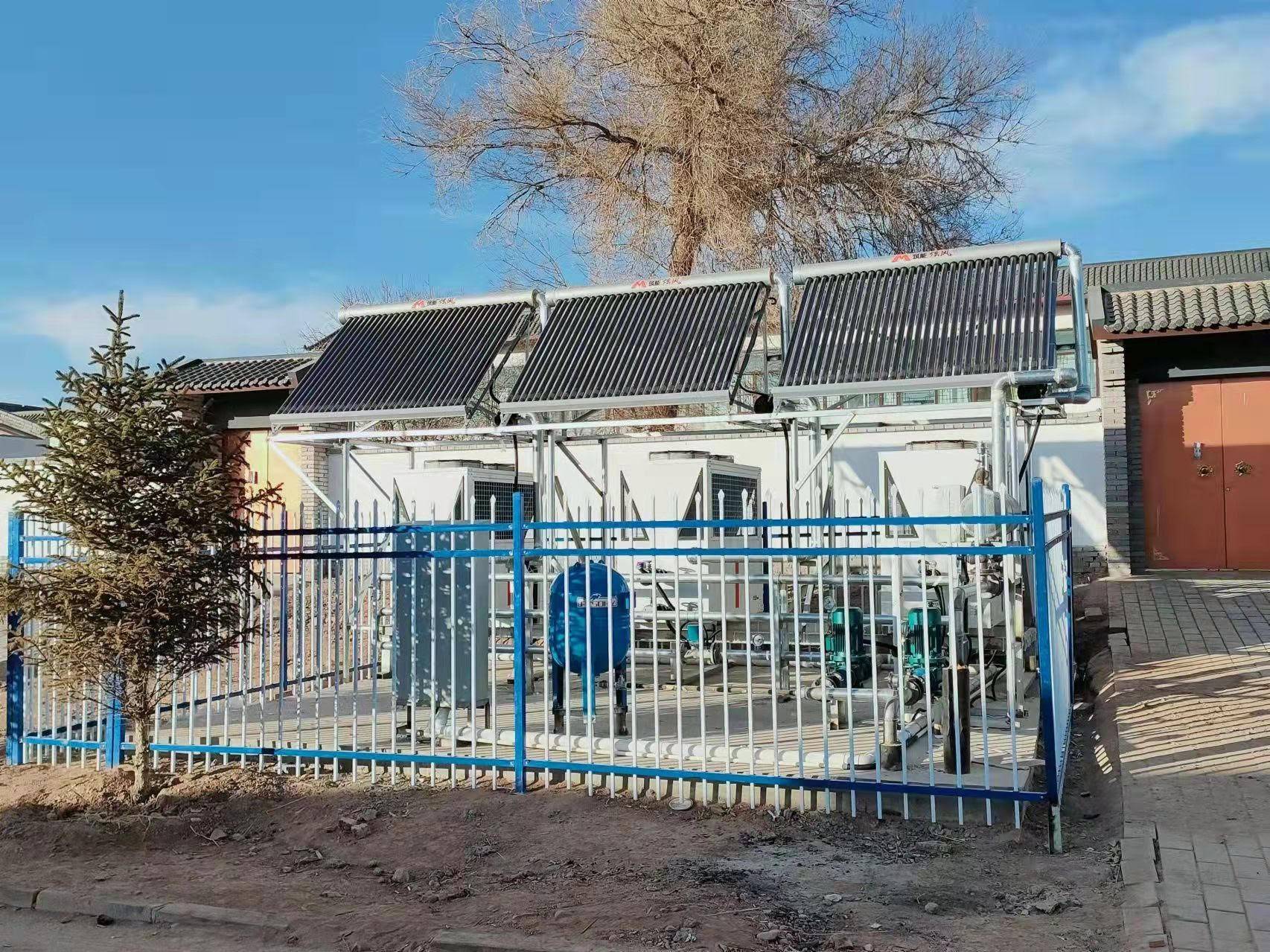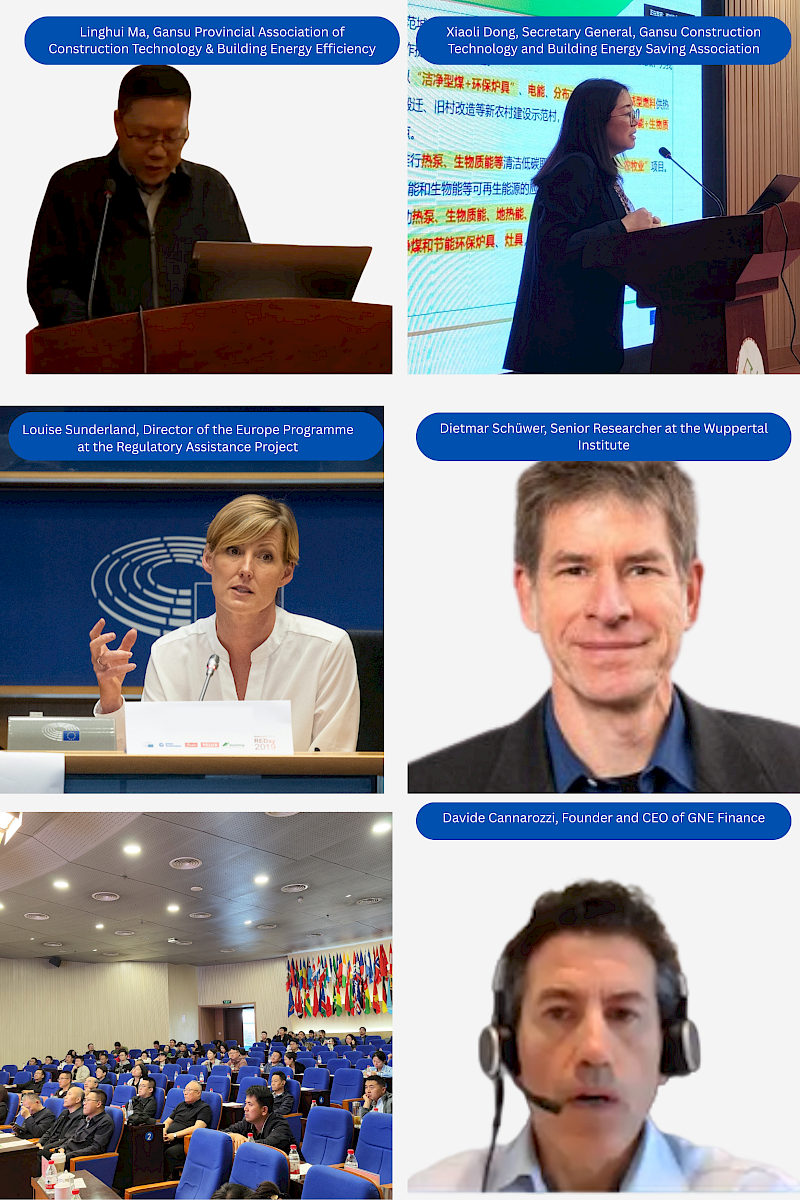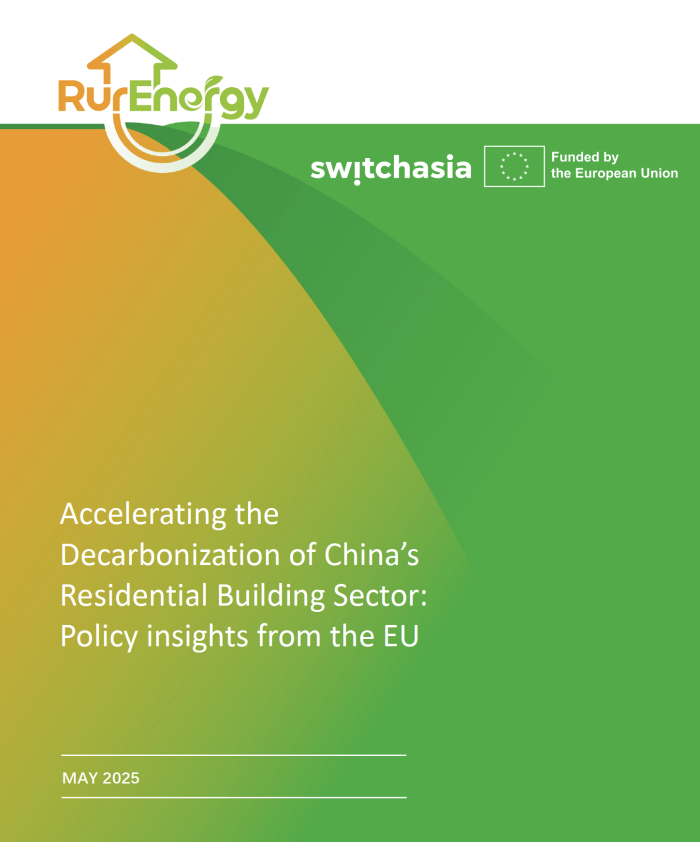
On April 28-29, 2025, policymakers, researchers, and energy experts from China and the European Union gathered in Lanzhou for a two-day policy dialogue and final project conference focused on accelerating the decarbonisation of residential buildings. Hosted both in-person and online, the events highlighted the urgent need for low-carbon housing solutions and showcased progress achieved under the EU-funded SWITCH-Asia RurEnergy project.
A Shared Commitment to Climate-Responsive Housing
 The EU-China Policy Dialogue on Residential Building Decarbonisation, held on April 28, underscored the significance of residential buildings in national decarbonisation strategies, given their substantial contribution to energy use and greenhouse gas emissions in both regions. The event opened with welcoming remarks from Mr. Linghui Ma, President of the Gansu Provincial Association of Construction Technology & Building Energy Efficiency, Ms. Guang Meng, Second-Level Investigator at the Department of Standards & Quotas of China’s Ministry of Housing and Urban-Rural Development, and Mr. Zhongnan Song, Deputy President of the China Association of Building Energy Efficiency (CABEE).
The EU-China Policy Dialogue on Residential Building Decarbonisation, held on April 28, underscored the significance of residential buildings in national decarbonisation strategies, given their substantial contribution to energy use and greenhouse gas emissions in both regions. The event opened with welcoming remarks from Mr. Linghui Ma, President of the Gansu Provincial Association of Construction Technology & Building Energy Efficiency, Ms. Guang Meng, Second-Level Investigator at the Department of Standards & Quotas of China’s Ministry of Housing and Urban-Rural Development, and Mr. Zhongnan Song, Deputy President of the China Association of Building Energy Efficiency (CABEE).
In the policy session, Mr. Pau Garcia Audi, Policy Officer at the European Commission’s Directorate-General for Energy (DG ENER), presented the EU’s approach under the recast Energy Performance of Buildings Directive (EPBD). He detailed core reforms including mandatory zero-emission standards for new buildings by 2030, a comprehensive phase-out of fossil fuel heating systems, and the integration of life-cycle greenhouse gas performance (GWP) calculations. He also highlighted the importance of a coherent policy ecosystem, where multiple EU legislative instruments and funding tools work in concert to support a fully decarbonised building stock.
From the Chinese side, Mr. Ye Wang, Division Director at CABEE, outlined China’s national framework for building decarbonisation under the 14th Five-Year Plan. He emphasized the government’s strategic commitment to green and low-carbon development, citing national targets as well as strong local implementation efforts. These include municipal-level policies encouraging ultra-low energy buildings and climate-responsive architectural design.
From Policy to Practice: Lessons from the Field
The second part of the dialogue turned to real-world applications and project experiences from both the EU and China. Ms. Mara Oprea, Expert at the Institute for European Energy and Climate Policy (IEECP), presented the RENOVERTY project, which focuses on overcoming renovation barriers in rural housing. She identified financial, regulatory, and geographical challenges and emphasized the importance of stakeholder co-creation and the development of renovation roadmaps that can be integrated into national legislation to ensure inclusive transitions.
Complementing this, Mr. Marcus Andreas from Climate Alliance introduced the EU Peers initiative and the concept of One-Stop-Shops (OSS). These centralized service hubs guide homeowners through the entire renovation process—from technical assessments and financial advice to contractor management. He shared successful OSS models and emphasized the importance of peer learning through EU-wide networks and national platforms.
From the Chinese side, Prof. Bin Hao, Head of R&D and Deputy Director at the Shenzhen Building Research Institute, discussed the need for renewable-based electrification and energy system flexibility. He introduced the PV-Energy Storage-Direct Current-Flexible Loads (PEDF) building model, a solution designed to address the time mismatch between solar energy generation and consumption. His presentation illustrated how national policy frameworks in China support such innovation, with several pilot projects already demonstrating effectiveness.
Dr. Xiaomin Liu, Senior Engineer at the Gansu Natural Energy Research Institute, further elaborated on this with pilot project results demonstrating the practical viability of photovoltaic/thermal (PVT) systems for clean residential heating. He emphasized the need to establish clear technical standards to guide the implementation of these systems and ensure consistent quality and performance at scale.
Cross-Regional Reflections and Mutual Learning
The day concluded with a roundtable discussion moderated by Ms. Mei Feng, Environment Officer at the Delegation of the European Union to China. Speakers reflected on areas of synergy and mutual learning. Mr. Wei Wang, Division Director at the Department of Housing and Urban-Rural Development of Gansu Province, noted the parallel decarbonisation trajectories between the EU and China, particularly the growing role of renewable energy in enabling clean heating systems.
Ms. Ying Zhang, former Deputy Director of the Department of Housing and Urban-Rural Development of Henan Province, shared regional best practices in housing policy and sustainability planning. Furthermore, Prof. Yong Wu, Key Expert of the RurEnergy project, emphasized the importance of people-centred renovation strategies that help residents understand the multiple benefits, economic, social, and environmental, of energy-efficient homes.
Dr. Stefan Thomas, Director of the Energy, Transport and Climate Policy Division at the Wuppertal Institute, drew comparisons between the EU and China in scaling up decarbonisation. He noted that while the EU can learn from China’s enforcement capacity, China may benefit from the EU’s experience with tools such as energy performance certificates and the OSS model. He also pointed to collaboration opportunities in areas such as clean electrification, flexibility services, and shared definitions of zero-emission buildings and GWP metrics.
RurEnergy Final Conference: Translating Research into Impact
 On April 29, the Final Conference of the RurEnergy Project gathered over 80 participants to reflect on the project's accomplishments and discuss future pathways for rural residential energy transitions. Opening remarks were delivered by Ms. Mei Feng, Environment Officer at the Delegation of the European Union to China, Mr. Zhongnan Song, China Association of Building Energy Efficiency (CABEE), and Mr. Linghui Ma, Gansu Provincial Association of Construction Technology & Building Energy Efficiency.
On April 29, the Final Conference of the RurEnergy Project gathered over 80 participants to reflect on the project's accomplishments and discuss future pathways for rural residential energy transitions. Opening remarks were delivered by Ms. Mei Feng, Environment Officer at the Delegation of the European Union to China, Mr. Zhongnan Song, China Association of Building Energy Efficiency (CABEE), and Mr. Linghui Ma, Gansu Provincial Association of Construction Technology & Building Energy Efficiency.
One of the highlights of the conference was the launch of a co-authored report, “Accelerating the Decarbonization of China's Residential Building Sector: Policy Insights from the EU,” jointly developed by the Wuppertal Institute and CABEE. The report builds on lessons from pilot initiatives in Henan and Gansu provinces and explores innovative business models and green financing mechanisms to support rural energy renovation.
In a dedicated forum on “Residential Building Decarbonization in the EU and China,” Prof. Yong Wu presented energy consumption patterns and cost-benefit analyses of low-energy rural housing in northern China. Mr. Dietmar Schüwer, Senior Researcher at the Wuppertal Institute, proposed a holistic approach to rural heating that includes diversified heat sources tailored to local conditions. Mr. Yanbiao Fu, Managing Director of Ningxia Xinfu Energy Service, shared an industry perspective on how PEDF building systems can be scaled up in practice.
Ms. Louise Sunderland, Director of the Europe Programme at the Regulatory Assistance Project, offered insights into EU policy strategies for electrification and how to unlock demand-side flexibility among households. Moreover, Mr. Yaoping Bai, Deputy General Manager of the Green Finance Department at CZ Bank, highlighted the role of commercial banks in supporting low-carbon and green building development. He showcased tailored financial products designed for this sector. Finally, Mr. Davide Cannarozzi, Founder and CEO of GNE Finance, presented successful EU case studies in green finance, identifying key enablers such as robust policy frameworks, strong market infrastructure, and targeted capacity-building efforts.
A Call for Continued Collaboration
Across both days, a consistent message emerged: decarbonising residential buildings requires integrated strategies combining policy, financing, innovation, and public engagement. The dialogues in Lanzhou demonstrated the immense potential of EU-China cooperation in building sustainable, low-carbon, and resilient housing systems.
As the global community accelerates efforts to meet climate goals, the insights and partnerships forged through these events offer a valuable blueprint for joint action on one of the most critical components of the energy transition—our homes.
__________________________________________________
Download the Report here
The European Union (EU) has set ambitious climate targets—climate neutrality by 2050 and at least a 55% reduction in greenhouse gas emissions by 2030, compared to 1990 levels. With buildings responsible for 34% of energy-related CO₂ emissions in 2022—and residential buildings alone emitting 306 MtCO₂ in 2021—improving energy efficiency in this sector is central to achieving these goals. To address this, the EU and its Member States have developed a broad policy mix, combining building energy codes, financial incentives, market-based tools, and public engagement measures. While implementation has varied across regions, the accumulated experience offers valuable insights for other countries pursuing similar goals. China, which aims to peak CO₂ emissions before 2030 and achieve carbon neutrality by 2060, faces a comparable challenge. In 2022, its residential building stock surpassed 53 billion m², with emissions from this sector exceeding 1.3 billion tonnes of CO₂—nearly 60% of all building-related emissions. The country has launched major initiatives, such as clean heating programs and enhanced urban energy standards, to curb this trend. This new flagship report from the RurEnergy project provides a comprehensive review of the EU’s approach to decarbonizing residential buildings. It outlines the overarching policy framework and offers a detailed analysis of key policy instruments. By showcasing recent EU policies, highlighting good practices from Member States, and identifying critical success factors, the report offers valuable insights. It also assesses current residential building policies in China, aiming to support efforts to accelerate decarbonization in China’s residential sector. Beyond this, the report contributes to the global dialogue on effective strategies for reducing emissions in the building sector.



